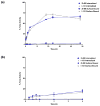Pairwise comparison of 89Zr- and 124I-labeled cG250 based on positron emission tomography imaging and nonlinear immunokinetic modeling: in vivo carbonic anhydrase IX receptor binding and internalization in mouse xenografts of clear-cell renal cell carcinoma
- PMID: 24604591
- PMCID: PMC4120276
- DOI: 10.1007/s00259-013-2679-1
Pairwise comparison of 89Zr- and 124I-labeled cG250 based on positron emission tomography imaging and nonlinear immunokinetic modeling: in vivo carbonic anhydrase IX receptor binding and internalization in mouse xenografts of clear-cell renal cell carcinoma
Abstract
Purpose: The PET tracer, (124)I-cG250, directed against carbonic anhydrase IX (CAIX) shows promise for presurgical diagnosis of clear-cell renal cell carcinoma (ccRCC) (Divgi et al. in Lancet Oncol 8:304-310, 2007; Divgi et al. in J Clin Oncol 31:187-194, 2013). The radiometal (89)Zr, however, may offer advantages as a surrogate PET nuclide over (124)I in terms of greater tumor uptake and retention (Rice et al. in Semin Nucl Med 41:265-282, 2011). We have developed a nonlinear immunokinetic model to facilitate a quantitative comparison of absolute uptake and antibody turnover between (124)I-cG250 and (89)Zr-cG250 using a human ccRCC xenograft tumor model in mice. We believe that this unique model better relates quantitative imaging data to the salient biological features of tumor antibody-antigen binding and turnover.
Methods: We conducted experiments with (89)Zr-cG250 and (124)I-cG250 using a human ccRCC cell line (SK-RC-38) to characterize the binding affinity and internalization kinetics of the two tracers in vitro. Serial PET imaging was performed in mice bearing subcutaneous ccRCC tumors to simultaneously detect and quantify time-dependent tumor uptake in vivo. Using the known specific activities of the two tracers, the equilibrium rates of antibody internalization and turnover in the tumors were derived from the PET images using nonlinear compartmental modeling.
Results: The two tracers demonstrated virtually identical tumor cell binding and internalization but showed markedly different retentions in vitro. Superior PET images were obtained using (89)Zr-cG250, owing to the more prolonged trapping of the radiolabel in the tumor and simultaneous washout from normal tissues. Estimates of cG250/CAIX complex turnover were 1.35 - 5.51 × 10(12) molecules per hour per gram of tumor (20 % of receptors internalized per hour), and the ratio of (124)I/(89)Zr atoms released per unit time by tumor was 17.5.
Conclusion: Pairwise evaluation of (89)Zr-cG250 and (124)I-cG250 provided the basis for a nonlinear immunokinetic model which yielded quantitative information about the binding and internalization of radioantibody bound to CAIX on tumor cells in vivo. (89)Zr-cG250 is likely to provide high-quality PET images and may be a useful tool to quantify CAIX/cG250 receptor turnover and cG250-accessible antigen density noninvasively in humans.
Figures






References
-
- Divgi CR, Pandit-Taskar N, Jungbluth AA, Reuter VE, Gonen M, Ruan S, et al. Preoperative characterisation of clear-cell renal carcinoma using iodine-124-labelled antibody chimeric G250 (124I-cG250) and PET in patients with renal masses: a phase I trial. Lancet Oncol. 2007;8:304–10. - PubMed
-
- Oosterwijk E, Ruiter DJ, Hoedemaeker PJ, Pauwels EK, Jonas U, Zwartendijk J, et al. Monoclonal antibody G 250 recognizes a determinant present in renal-cell carcinoma and absent from normal kidney. Int J of Cancer. 1986;38:489–94. - PubMed
Publication types
MeSH terms
Substances
Grants and funding
- P50 CA 086438-13/CA/NCI NIH HHS/United States
- P50-CA92629/CA/NCI NIH HHS/United States
- P50 CA092629/CA/NCI NIH HHS/United States
- P30 CA008748/CA/NCI NIH HHS/United States
- R21 CA153177/CA/NCI NIH HHS/United States
- R25-CA096945/CA/NCI NIH HHS/United States
- R24-CA83084/CA/NCI NIH HHS/United States
- P30-CA08748/CA/NCI NIH HHS/United States
- P50 CA086438/CA/NCI NIH HHS/United States
- R25 CA096945/CA/NCI NIH HHS/United States
- R21 CA153177-03/CA/NCI NIH HHS/United States
- R00 CA172695/CA/NCI NIH HHS/United States
- R24 CA083084/CA/NCI NIH HHS/United States
LinkOut - more resources
Full Text Sources
Other Literature Sources
Medical

